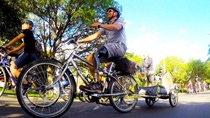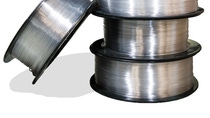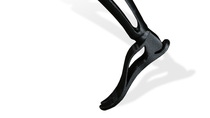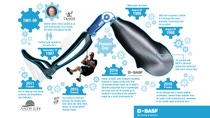Media
Amputee makes prosthetics to help others walk again
Chris Casteel collaborates with BASF and Essentium to bring revolutionary 3D-printed sockets to life.

It was a warm and sunny Friday on August 26, 1988. Chris Casteel, then a 24-year-old newlywed, decided to hop on his Yamaha Maxim 650 motorcycle to drive to work. It was his third week on the job at an industrial facility where he worked the second shift. The Detroit native was an avid motorcyclist. He’s owned dirt bikes throughout his life and has been actively riding motorcycles since 1981. But that day, his life was about to change forever.
As he was driving on a winding road on River Drive in Detroit, he saw two students inside a car, who looked distracted while driving towards him.
“I realized they were over the line and I remember locking up the brakes and trying to hold on for dear life,” Casteel told BASF in an interview.
The car struck him nearly head on into one of the curbs. “It was one of those Michigan no-fault things,” Casteel added.
The young motorcyclist blacked out for a few of days after his left leg had been amputated due to the trauma. He had a couple of surgeries and a revision surgery two days later, amputating from a below-knee to a through-the-knee level. As his one-year wedding anniversary came around a few weeks later— he and his wife celebrated the occasion at his hospital bed. And then he remembers living in a daydream for a couple of years, as his mind was getting used to living with his new disability.
That was 30 years ago. Today, Casteel is a through-the-knee amputee who wears a trans-femoral prosthetic. He’s more active than ever—taking part in daily city bike rides, and he’s paying it forward by helping others walk again.
As a board-certified orthotist and board-eligible prosthetist, Casteel helps patients from all walks of life to be mobile again post-limb loss.
He recalls making his very first above-knee prosthetic for a young kid while working as an entry-level technician. The boy came on crutches and Casteel observed the fitting.
“After some adjustments by the prosthetist, the kid went from walking to running in less than an hour. I cried like a baby right there. (The kid) was absolutely fearless,” he said. Casteel’s course was set from that point on.
Fast forward to 2018, Casteel is now the owner of Anew Life Prosthetics and Orthotics. While his company is for profit, he’s known to not shy away from pro-bono work for patients from all walks of life—including the underinsured, and the homeless. He’s even gone as far as third-world countries, and invited children from war-torn areas to his clinic in The Motor City to make them a prosthetic leg so they could walk again. Although he sometimes doesn’t get reimbursed for his efforts, the reward he gets back is priceless.
“When you see someone actually walking, returning to life, living with something you’ve created, it makes up for those times that the insurance company doesn’t pay,” Casteel added.
The number of people in need of prosthetics is plentiful and the amount of time it takes to make a prosthetic takes days.
“For us to manually hand-cast someone, create a plaster model, modify it, pull a test socket, it takes a couple of days and a few man hours,” he said.
But now there’s a solution to that problem, which is about to revolutionize the prosthetic industry—the new 3D-printed prosthetic socket.
.jpg)


To help improve the prosthetics field, the clinician recently teamed up with BASF Corp. and Essentium Inc., a 3D-printing and materials development company to try out a revolutionary prosthetic socket on his patients. The socket is 3D-printed with BASF’s Ultramid polyamide (nylon) reinforced with short carbon fiber that is manufactured by Essentium division, TriFusion Devices.
What makes this socket stand out among traditional carbon sockets is that it’s lightweight yet tough and more flexible.
“It’s one thing to hear about it, it’s another thing to actually feel and touch it,” Casteel said, while holding the socket in his hand. “The adjustability is probably the biggest feature. The new material allows us to heat it up and move it around and not have to grind into it.”
While Casteel hasn’t gotten around to testing the socket on himself just yet, he’s already fitted about 50 of his patients with it. The process entails Casteel scanning the patient and then Essentium printing the prosthetic for each person. The patients try on the test sockets first at Casteel’s office, so that their bodies adjust to the fit. Later, they’re fitted for a definitive socket, made with the Ultramid polyamide. This material keeps the prosthetic strong anywhere between 3 -5 years, according to Josh Lawson, Head of Marketing at Essentium. (Traditionally manufactured prosthetic sockets typically last less than 3 years).
Additive manufacturing (another name for 3D printing) also eliminates human errors, ensuring the socket fits correctly the first time. This means that the amount of time it will take to fit someone for a prosthetic limb is reduced by 50%. Also, while old sockets are non-adjustable, the new material can be heated up post-3D printing and adjusted accordingly to fit the patient comfortably. So, if the patient grows, loses or gains weight, the prosthetic can now be changed and fitted to his or her present size.
“3D printing is really the way of the future. It’s going to expand exponentially and we’re trying to be on the leading edge of that,” said Charles Tazzia, Senior Technology and Business Scout, Performance Materials, BASF, who was responsible for bringing the three parties (BASF, Essentium and Casteel) together.
Tazzia met Casteel a few years back during the famous Detroit weekly bike ride called Slow Roll, which attracts thousands of participants. The two became fast friends and Tazzia brought Casteel onboard to have his patients try out the new 3D-printed prosthetic that is shaking up the industry. Tazzia doesn’t hide his fondness for his clinician friend.
“It’s rare that we get the opportunity to see our materials actually make people’s lives better. And that’s why this work with Chris has been so rewarding.”
Published by Anna Spiewak.
For media inquiries or to repurpose this article, please contact Lisa Brown.